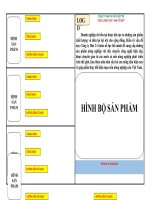EPA an introduction to freshwater fishesas biological indicators EPA 260 r 08 016 tủ tài liệu bách khoa
Bạn đang xem bản rút gọn của tài liệu. Xem và tải ngay bản đầy đủ của tài liệu tại đây (3.07 MB, 96 trang )
An Introduction to
Freshwater Fishes as
Biological Indicators
EPA-260-R-08-016
November 2008
An Introduction to Freshwater Fishes
as Biological Indicators
Prepared by:
Jeffrey D. Grabarkiewicz1 and Wayne S. Davis2
1
Ecological Survey and Design, LLC
1517 W. Temperance Rd.
Temperance, MI 48182
U.S. Environmental Protection Agency
Office of Environmental Information
Office of Information Analysis and Access
Washington, DC 20460
2
U.S. Environmental Protection Agency
Office of Environmental Information
Office of Information Analysis and Access
Washington, DC 20460
Printed on chlorine free 100% recycled paper with
100% post-consumer fiber using vegetable-based ink.
Notice
This document has been reviewed and approved in accordance with U.S. Environmental Protection
Agency policy. Mention of trade names, products, or services does not convey and should not be
interpreted as conveying official EPA approval, endorsement, or recommendation for use.
Funding was provided by the U.S. Environmental Protection Agency under Contract # 68-C-04
006, Work Assignment #4-79 with the Great Lakes Environmental Center, Inc.
The appropriate citation for this report is:
Grabarkiewicz, J. and W. Davis. 2008. An introduction to freshwater fishes as biological indicators.
EPA-260-R-08-016. U.S. Environmental Protection Agency, Office of Environmental Information,
Washington, DC.
The entire document can be downloaded from:
/>
AckNowledgemeNts
We would like to thank the many individuals who provided manuscripts and papers for our review
and reference. We would also like to thank the various reviewers who provided valuable comments
regarding the format and content of this guide including James Kurtenbach, Louis Reynolds, Scott
Stranko, and Richard Spear.
iv
An Introduction to Freshwater Fishes as Biological Indicators
coNteNts
Notice.........................................................................................................................................iv
Acknowledgements..................................................................................................................iv
Introduction............................................................................................................................... 1
Basic Fish Anatomy ................................................................................................................. 3
Fish as Biological Indicators................................................................................................... 4
Index of Biotic Integrity (IBI).................................................................................................... 6
Sampling Fish Populations...................................................................................................... 8
Fish Habitats .............................................................................................................................10
Family and Species Accounts.................................................................................................12
Lampreys (Petromyzontidae)...................................................................................................13
Chestnut Lamprey (Ichthyomyzon castaneus)................................................................15
American Brook Lamprey (Lampetra appendix) .............................................................15
Sturgeons (Acipenseridae)......................................................................................................16
Lake Sturgeon (Acipenser fulvescens) ...........................................................................18
Shovelnose Sturgeon (Scaphirhynchus platorynchus) ...................................................18
Minnows (Cyprinidae) ..............................................................................................................19
Central Stoneroller (Campostoma anomalum) ...............................................................22
Redside Dace (Clinostomus elongatus) .........................................................................22
Common Carp (Cyprinus carpio)....................................................................................23
Streamline Chub (Erimystax dissimils) ...........................................................................23
Gravel Chub (Erimystax x-punctatus) .............................................................................24
Crescent Shiner (Luxilus cerasinus) ...............................................................................24
Striped Shiner (Luxilus chrysocephalus) ........................................................................25
Common Shiner (Luxilus cornutus) ................................................................................25
River Chub (Nocomis micropogon).................................................................................26
Silverjaw Minnow (Notropis buccatus) ............................................................................26
Rosyface Shiner (Notropis rubellus) ...............................................................................27
Pugnose Minnow (Opsopoeodus emiliae) ......................................................................27
Bluntnose Minnow (Pimephales notatus) .......................................................................28
Blacknose Dace (Rhynichthys atratulus) ........................................................................28
Longnose Dace (Rhynichthys cataractae) ......................................................................29
Creek Chub (Semotilus atromaculatus)..........................................................................29
Suckers (Catostomidae) ..........................................................................................................30
Quillback (Carpiodes cyprinus).......................................................................................31
White Sucker (Catostomus commersoni) .......................................................................31
Northern Hog Sucker (Hypentileum nigricans) ...............................................................32
Smallmouth Buffalo (Ictiobus bubulas)............................................................................32
Spotted Sucker (Minytrema melanops)...........................................................................33
Golden Redhorse (Moxostoma erythrurum) ...................................................................33
Shorthead Redhorse (Moxostoma macrolepidotum) ......................................................34
Black Jumprock (Scartomyzon cervinus)........................................................................34
An Introduction to Freshwater Fishes as Biological Indicators
v
coNteNts (coN’t)
Catfishes (Ictaluridae) ..............................................................................................................36
Channel Catfish (Ictalurus punctatus).............................................................................38
Stonecat Madtom (Noturus flavus) .................................................................................38
Tadpole Madtom (Notorus gyrinus).................................................................................39
Brindled Madtom (Noturus miurus).................................................................................39
Trouts (Salmonidae) .................................................................................................................40
Rainbow Trout (Oncorhynchus mykiss)...........................................................................42
Brown Trout (Salmo trutta) ..............................................................................................42
Brook Trout (Salvelinus fontinalis)...................................................................................43
Lake Trout (Salvelinus namaycush) ................................................................................43
Pikes (Esocidae) .......................................................................................................................44
Grass Pickerel (Esox americanus vermiculatus) ............................................................46
Northern Pike (Esox lucius) ............................................................................................46
Topminnows and Killifishes (Fundulidae)..............................................................................47
Western Banded Killifish (Fundulus d. diaphanus) .........................................................49
Blackstripe Topminnow (Fundulus notatus) ....................................................................49
Sculpins (Cottidae)...................................................................................................................50
Mottled Sculpin (Cottus bairdi)........................................................................................52
Banded Sculpin (Cottus carolinae) .................................................................................52
Sunfishes (Centrarchidae).......................................................................................................53
Rock Bass (Ambloplites rupestris)..................................................................................55
Bluespotted Sunfish (Enneacanthus gloriosus) ..............................................................55
Redbreast Sunfish (Lepomis auritus) .............................................................................56
Green Sunfish (Lepomis cyanellus)................................................................................56
Pumpkinseed Sunfish (Lepomis gibbosus).....................................................................57
Warmouth Sunfish (Lepomis gulosus)............................................................................57
Orangespotted Sunfish (Lepomis humilis)......................................................................58
Bluegill Sunfish (Lepomis macrochirus)..........................................................................58
Dollar Sunfish (Lepomis marginatus)..............................................................................59
Longear Sunfish (Lepomis megalotis) ............................................................................59
Spotted Sunfish (Lepomis punctatus).............................................................................60
Smallmouth Bass (Micropterus dolomieu) ......................................................................60
Largemouth Bass (Micropterus salmoides) ....................................................................61
Black Crappie (Pomoxis nigromaculatus) .......................................................................61
Perches (Percidae)....................................................................................................................62
Eastern Sand Darter (Ammocrypta pellucida)................................................................65
Greenside Darter (Etheostoma blennioides) ..................................................................65
Rainbow Darter (Etheostoma caeruleum) ......................................................................66
Bluebreast Darter (Etheostoma camurum).....................................................................66
Fantail Darter (Etheostoma flabellare)............................................................................67
Redband Darter (Etheostoma luteovinctum) ..................................................................67
vi
An Introduction to Freshwater Fishes as Biological Indicators
coNteNts (coN’t)
Spotted Darter (Etheostoma maculatum) .......................................................................68
Redline Darter (Etheostoma rufilineatum) ......................................................................68
Orangethroat Darter (Etheostoma spectabile)................................................................69
Speckled Darter (Etheostoma stigmaeum).....................................................................69
Variegate Darter (Etheostoma variatum) ........................................................................70
Banded Darter (Etheostoma zonale) ..............................................................................70
Yellow Perch (Perca flavescens) .....................................................................................71
Logperch (Percina caprodes)..........................................................................................71
Channel Darter (Percina copelandi) ...............................................................................72
Gilt Darter (Percina evides).............................................................................................72
Slenderhead Darter (Percina phoxocephala)..................................................................73
Roanoke Darter (Percina roanoka).................................................................................73
Dusky Darter (Percina sciera).........................................................................................74
Walleye (Stizostedion vitreus).........................................................................................74
Literature Cited .........................................................................................................................75
An Introduction to Freshwater Fishes as Biological Indicators
vii
Figures
Figure 1. Mouth orientations ...................................................................................................... 3
Figure 2. Caudal fin shapes....................................................................................................... 3
Figure 3. Branchiostegal membranes ........................................................................................ 3
Figure 4: Basic body regions ..................................................................................................... 3
Figure 5: Basic fin anatomy ....................................................................................................... 3
Figure 6: Basic head anatomy ................................................................................................... 3
Figure 7: A hypothetical watershed............................................................................................ 10
tAbles
Table 1. Original IBI Metrics (Karr 1981; Karr et al. 1986) ......................................................... 6
Table 2. Great River IBI Metrics (Simon and Emery 1995)........................................................ 7
Table 3. Overview of Pollution Tolerance for Family Petromyzontidae ....................................... 13
Table 4. Tolerance designations for selected petromyzontids .................................................... 14
Table 5. Overview of Pollution Tolerance for Family Acipenseridae ........................................... 16
Table 6. Tolerance designations for selected acipenserids ........................................................ 17
Table 7. Overview of Pollution Tolerance for Family Cyprinidae................................................. 19
Table 8. Tolerance designations for selected cyprinids .............................................................. 21
Table 9. Overview of Pollution Tolerance for Family Catostomidae............................................ 30
Table 10. Tolerance designations for selected catostomids ....................................................... 31
Table 11. Overview of Pollution Tolerance for Family Ictaluridae ............................................... 36
Table 12. Tolerance designations for selected ictalurids ............................................................ 37
Table 13. Overview of Pollution Tolerance for Family Salmonidae ............................................. 40
Table 14. Tolerance designations for selected salmonids .......................................................... 41
Table 15. Overview of Pollution Tolerance for Family Esocidae ................................................. 44
Table 16. Tolerance designations for selected esocids .............................................................. 45
Table 17. Overview of Pollution Tolerance for Family Fundulidae .............................................. 47
Table 18. Tolerance designations for selected fundulids ............................................................ 48
Table 19. Overview of Pollution Tolerance for Family Cottidae................................................... 50
Table 20. Tolerance designations for selected cottids ................................................................ 51
Table 21. Overview of Pollution Tolerance for Family Centrarchidae ......................................... 53
Table 22. Tolerance designations for selected centrarchids....................................................... 54
Table 23. Overview of Pollution Tolerance for Family Percidae .................................................. 62
Table 24. Tolerance designations for selected percids............................................................... 64
viii
An Introduction to Freshwater Fishes as Biological Indicators
PhotogrAPhs
Cover (all photos by Jeff Grabarkiewicz and Todd Crail)
Notice/Acknowledgements
Blenny Darter (Top left), Duck River, TN (T. Crail) ..................................................................... iv
Speckled Darter (Top right), unknown locality, TN (J. Grabarkiewicz) ....................................... iv
Tennessee Snubnose Darter (Bottom left), Little Buffalo River, TN (T. Crail)............................. iv
Rainbow Darter (Bottom right), Blanchard River, OH (J. Grabarkiewicz) .................................. iv
The Conservation of Fishes
Photo 1: Spring Cavefish, Some Creek, TN (T. Crail) ................................................................ 1
Photo 2: Tangerine Darter, Tennessee Aquarium (W. Davis) ..................................................... 1
Photo 3: Greenfin Darter, Ivy Creek, NC (T. Crail) ..................................................................... 2
Photo 4: Mobile Logperch, Borden Creek, AL (J. Grabarkiewicz) ............................................. 2
Basic Fish Anatomy
All photos and drawings by J. Grabarkiewicz............................................................................. 3
Fish as Biological Indicators
Photo 5: Cacapon River, WV (J. Grabarkiewicz)........................................................................ 4
Sampling Fish Populations
Photo 6: A sampler using a backpack electroshocker, unknown state (W. Davis) ..................... 8
Photo 7: A pair using a seine to capture various darters, Chagrin River,
OH (J. Grabarkiewicz) ................................................................................................. 8
Photo 8: A downstream sampling blockade, unknown state (W. Davis) .................................... 9
Fish Habitats
Photo 9: Floodplain during spring, Scioto River floodplain, OH (J. Grabarkiewicz) ................... 11
Photo 10: An agricultural headwater channel in a low-gradient region of the
Midwest, Swan Creek, OH (J. Grabarkiewicz)........................................................... 11
Lampreys
Adult Chesnut Lamprey (top and bottom), Little Buffalo River, TN (T. Crail) .............................. 13
Sea Lamprey, Lake Erie, OH (T. Crail)....................................................................................... 14
Chestnut Lamprey (A and B), Little Buffalo River, TN (T. Crail) ................................................. 15
American Brook Lamprey (A and B), Macochee Creek headwater, OH (J. Grabarkiewicz) ...... 15
Sturgeons
Shovelnose Sturgeon (top and bottom), Missouri River, MO (T. Crail) ...................................... 16
Lake Sturgeon, Newport Aquarium (W. Davis) .......................................................................... 17
Lake Sturgeon (A and B), Newport Aquarium (W. Davis) .......................................................... 18
Shovelnose Sturgeon (A and B), Missouri River, MO (T. Crail) ................................................. 18
Minnows
Bluenose Shiner, Yellow River, FL (T. Crail) ............................................................................... 19
Tricolor Shiner, Swamp Creek, AL (T. Crail)............................................................................... 19
Pinewood Shiner, Eno River, NC (T. Crail)................................................................................. 20
Stoneroller Minnow (A), Ten Mile Creek, OH (T. Crail)............................................................... 23
Stoneroller Minnow (B), Big Darby Creek, OH (J. Grabarkiewicz)............................................. 23
Redside Dace (A), Macochee Creek, OH (T. Crail) ................................................................... 23
Redside Dace (B), St. Joseph Creek, MI (J. Grabarkiewicz) ..................................................... 23
Common Carp mirror variety (A), Maumee River, OH (T. Crail)................................................. 23
Common Carp mirror variety (B), Blanchard River, OH (J. Grabarkiewicz) ............................... 23
An Introduction to Freshwater Fishes as Biological Indicators
ix
PhotogrAPhs (coN’t)
Minnows (con’t)
Streamline Chub (A), Big Darby Creek, OH (T. Crail) ................................................................ 23
Streamline Chub (B), Clinch River, TN (J. Grabarkiewicz)......................................................... 23
Gravel Chub (A and B), Duck River, TN (T. Crail) ...................................................................... 24
Crescent Shiner (A), South Hyco Creek, NC (T. Crail) .............................................................. 24
Habitat of the Crescent Shiner (B), Roanoke River, VA (J. Grabarkiewicz) ............................... 24
Striped Shiner (A), Big Darby Creek, OH (J. Grabarkiewicz)..................................................... 25
Striped Shiner (B), Ten Mile Creek, OH (T. Crail) ...................................................................... 25
Common Shiner (A and B), French Creek (Schuylkill), PA (J. Grabarkiewicz) .......................... 25
River Chub (A and B), River Raisin, MI (J. Grabarkiewicz)........................................................ 26
Silverjaw Minnow (A), “The Outlet”, OH (T. Crail) ...................................................................... 26
Silverjaw Minnow (B), Blacklick Creek, OH (J. Grabarkiewicz).................................................. 26
Rosyface Shiner (A), Blacklick Creek, OH (J. Grabarkiewicz) ................................................... 27
Rosyface Shiner (B), River Raisin, MI (J. Grabarkiewicz).......................................................... 27
Pugnose Minnow (A and B), Yellow River, FL (T. Crail).............................................................. 27
Bluntnose Minnow (A), Blanchard River, OH (T. Crail) .............................................................. 28
Bluntnose Minnow (B), Maumee River, OH (J. Grabarkiewicz) ................................................. 28
Blacknose Dace (A), French Creek (Schuylkill), PA (J. Grabarkiewicz) ..................................... 28
Habitat of the Blacknose Dace (B), French Creek, PA (J. Grabarkiewicz)................................. 28
Longnose Dace (A), French Creek (Schuylkill), PA (J. Grabarkiewicz)...................................... 29
Habitat of the Longnose Dace (B), French Creek, PA (J. Grabarkiewicz).................................. 29
Creek Chub (A and B), Indian Creek, MI (J. Grabarkiewicz) ..................................................... 29
Suckers
White Sucker (top), French Creek (Schuylkill), PA (J. Grabarkiewicz) ....................................... 30
Blacktail Redhorse (bottom), Swamp Creek, AL (T. Crail) ......................................................... 30
Blue Sucker, Albuquerque Aquarium exhibit (W. Davis) ............................................................ 31
Quillback (A and B), Maumee River, OH (T. Crail)..................................................................... 32
White sucker (A), French Creek (Schuylkill), PA (J. Grabarkiewicz) .......................................... 32
White sucker (B), Ottawa River (Toledo), OH (T. Crail) .............................................................. 32
Northern Hog Sucker (A), Big Darby Creek, OH (J. Grabarkiewicz).......................................... 33
Northern Hog Sucker (B), St. Joseph Creek, MI (J. Grabarkiewicz) .......................................... 33
Smallmouth Buffalo (A and B), Newport Aquarium, KY (W. Davis) ........................................... 33
Spotted Sucker (A and B), East Fork West Branch St. Joseph River, MI (T. Crail) .................... 34
Golden Redhorse (A and B), East Fork West Branch St. Joseph River, MI (T. Crail) ................ 34
Shorthead Redhorse (A and B), Maumee River, OH (T. Crail) .................................................. 35
Black Jumprock (A), upper Roanoke River, VA (J. Grabarkiewicz) ............................................ 35
Habitat of the Black Jumprock (B), Roanoke River, VA (J. Grabarkiewicz)................................ 35
Catfishes
Tadpole Madtom, Maumee River, OH (T. Crail) ......................................................................... 36
Mountain Madtom, Big Darby Creek, OH (T. Crail).................................................................... 36
Stonecat Madtom, Big Darby Creek, OH (T. Crail) .................................................................... 37
Channel Catfish (A and B), Maumee River, OH (T. Crail) .......................................................... 38
Stonecat Madtom (A), Fish Creek, OH (J. Grabarkiewicz) ........................................................ 38
Stonecat Madtom (B), Big Darby Creek, OH (T. Crail)............................................................... 38
x
An Introduction to Freshwater Fishes as Biological Indicators
PhotogrAPhs (coN’t)
Catfishes (con’t)
Tadpole Madtom (A), Maumee River, OH (T. Crail) ................................................................... 39
Tadpole Madtom (B), The Outlet, OH (J. Grabarkiewicz)........................................................... 39
Brindled Madtom (A), Swan Creek, OH (J. Grabarkiewicz) ....................................................... 39
Brindled Madtom (B), Blanchard River, OH (J. Grabarkiewicz) ................................................. 39
Trouts
Rainbow Trout, Tennessee Aquarium,TN (W. Davis) ................................................................. 40
Brook Trout, Shinagawa Aquarium, Japan (W. Davis) ............................................................... 40
Lake Trout, unknown location (W. Davis) ................................................................................... 41
Brook Trout, Tennessee Aquarium, TN (W. Davis) ..................................................................... 41
Rainbow Trout (A and B), Tennessee Aquarium, TN (W. Davis) ................................................ 42
Brown Trout (A), Denver Aquarium, CO (W. Davis) ................................................................... 42
Introduced habitat of the Brown Trout (B), Macochee Creek, OH (J. Grabarkiewicz)................ 42
Brook Trout (A), Woodiebrook Creek, OH (T. Crail) ................................................................... 43
Brook Trout (B), Shinagawa Aquarium, Japan (W. Davis).......................................................... 43
Lake Trout (A and B), Great Lakes Aquarium, MN (W. Davis) ................................................... 43
Pikes
Northern Pike, Ottawa River, Toledo, OH (J. Grabarkiewicz)..................................................... 44
Grass Pickerel, ditch, Toledo, OH (J. Grabarkiewicz)................................................................. 44
Esox spp., French Creek (Schuylkill), PA (J. Grabarkiewicz) ..................................................... 45
Grass Pickerel (A), East Fork West Branch St. Joseph River, MI (J. Grabarkiewicz) ................ 46
Grass Pickerel (B), ditch, Toledo, OH (J. Grabarkiewicz)........................................................... 46
Northern Pike (A), East Fork West Branch St. Joseph River, MI (J. Grabarkiewicz).................. 46
Northern Pike (B), Prairie Ditch, OH (T. Crail) ........................................................................... 46
Topminnows
Russetfin Topminnow, Blackwater River (T. Crail)...................................................................... 47
Lined Topminnow, unknown (T. Crail) ........................................................................................ 47
Longnose Killifish, tidal stream, Geiger Key, FL (T. Crail) .......................................................... 47
Western Banded Killifish, Maumee River, OH (T. Crail)............................................................. 48
Western Banded Killifish (A), Round Lake, MI (J. Grabarkiewicz) ............................................. 49
Habitat of the Western Banded Killifish (B), Devil’s Lake, MI (J. Grabarkiewicz) ....................... 49
Blackstripe Topminnow (A and B), The Outlet, OH (T. Crail)...................................................... 49
Sculpins
Mottled Sculpin (top left), St. Joseph Creek, MI (J. Grabarkiewicz)........................................... 50
Mottled Sculpin (top right), Fish Creek, OH (J. Grabarkiewicz) ................................................. 50
Habitat of the Banded Sculpin (bottom center), unknown trib, AL (J. Grabarkiewicz) ............... 50
Banded Sculpin, unknown trib, AL (J. Grabarkiewicz) ............................................................... 51
Mottled Sculpin (A), St. Joseph Creek, MI (J. Grabarkiewicz) ................................................... 52
Mottled Sculpin (B), Fish Creek, OH (J. Grabarkiewicz)............................................................ 52
Banded Sculpin (A), unknown trib, AL (J. Grabarkiewicz) ......................................................... 52
Habitat of the Banded Sculpin (B), unknown trib, AL (J. Grabarkiewicz) ................................... 52
An Introduction to Freshwater Fishes as Biological Indicators
xi
PhotogrAPhs (coN’t)
Sunfishes
Dollar Sunfish (Top left), Tennessee Aquarium, TN (J. Grabarkiewicz) ..................................... 53
Spotted Bass (Top right), Cowarts Creek, AL (T. Crail) ............................................................. 53
Smallmouth Bass (Bottom left), Unknown (T. Crail)................................................................... 53
Orangespotted Sunfish, Maumee River, OH (T. Crail) ............................................................... 53
Longear Sunfish, The Outlet, OH (T. Crail) ................................................................................ 54
Rock Bass (A), Fish Creek, OH (J. Grabarkiewicz) ................................................................... 55
Rock Bass (B), Maumee River, OH (J. Grabarkiewicz).............................................................. 55
Bluespotted Sunfish (A), Tennessee Aquarium, TN (W. Davis) ................................................. 55
Bluespotted Sunfish (B), Yellow River, FL (T. Crail) ................................................................... 55
Redbreast Sunfish (A), Saluda River drainage, SC (T. Crail)..................................................... 56
Redbreast Sunfish (B), Capacon River, WV (J. Grabarkiewicz) ................................................ 56
Green Sunfish (A), Maumee River, OH (T. Crail) ....................................................................... 56
Habitat of the Green Sunfish (B), Fast Ditch, OH (J. Grabarkiewicz) ........................................ 56
Pumpkinseed Sunfish (A), Maumee River, OH (T. Crail) ........................................................... 57
Pumpkinseed Sunfish (B), Maumee River, OH (J. Grabarkiewicz) ............................................ 57
Warmouth Sunfish (A), Lake Wilson, MI (T. Crail)...................................................................... 57
Habitat of the Warmouth Sunfish (B), Lake Wilson, MI (J. Grabarkiewicz) ................................ 57
Orangespotted Sunfish (A and B), Maumee River, OH (T. Crail)............................................... 58
Bluegill Sunfish (A), unknown aquarium (W. Davis)................................................................... 58
Bluegill Sunfish (B), Mohican River, OH (T. Crail)...................................................................... 58
Dollar Sunfish (A), Tennessee Aquarium, OH (J. Grabarkiewicz).............................................. 59
Dollar Sunfish (B), unknown locality (T. Crail)............................................................................ 59
Longear Sunfish (A), The Outlet, OH (J. Grabarkiewicz) ........................................................... 59
Longear Sunfish (B), The Outlet, OH (T. Crail) .......................................................................... 59
Spotted Sunfish (A and B), Rainbow River, FL (T. Crail) ........................................................... 60
Smallmouth Bass (A), Little Beaver Creek, OH (T. Crail)........................................................... 60
Smallmouth Bass (B), Cacapon River, WV (J. Grabarkiewicz) .................................................. 60
Largemouth Bass (A), unknown aquarium (W. Davis) ............................................................... 61
Largemouth Bass (B), Cacapon River, WV (J. Grabarkiewicz).................................................. 61
Black Crappie (A), Auglaize River drainage, OH (J. Grabarkiewicz).......................................... 61
Black Crappie (B), Delaware Creek, OH (T. Crail) ..................................................................... 61
Perches
Greenside Darters (top), Swan Creek, OH (J. Grabarkiewicz) .................................................. 62
Bloodfin Darter (bottom), Collins River, TN (T. Crail) ................................................................. 62
Redline Darter, Duck River, TN (J. Grabarkiewicz) .................................................................... 63
Redline Darter, Clinch River, TN (J. Grabarkiewicz) .................................................................. 63
Eastern Sand Darter (A), Paint Creek, OH (T. Crail) ................................................................. 65
Historic habitat of the Eastern Sand Darter (B), Green River, KY (J. Grabarkiewicz) ............... 65
Greenside Darter (A and B), Swan Creek, OH (J. Grabarkiewicz) ............................................ 65
Rainbow Darter (A), Blanchard River, OH (J. Grabarkiewicz) ................................................... 66
Rainbow Darter (B), Scioto River, OH (J. Grabarkiewicz).......................................................... 66
Bluebreast Darter (A), Big Darby Creek, OH (J. Grabarkiewicz) ............................................... 66
Bluebreast Darter (B), Paint Creek, OH (T. Crail) ...................................................................... 66
Fantail Darter (A and B), Blanchard River, OH (J. Grabarkiewicz) ............................................ 67
xii
An Introduction to Freshwater Fishes as Biological Indicators
PhotogrAPhs (coN’t)
Perches (con’t)
Redband Darter (A), unknown trib, TN (J. Grabarkiewicz)......................................................... 67
Habitat of the Redband Darter (B), unknown trib, TN (J. Grabarkiewicz) .................................. 67
Spotted Darter (A and B), Green River, KY (J. Grabarkiewicz) ................................................. 68
Redline Darter (A), Duck River, TN (J. Grabarkiewicz) .............................................................. 68
Redline Darter (B), Clinch River, TN (J. Grabarkiewicz) ............................................................ 68
Orangethroat Darter (A and B), Ten Mile Creek, OH (J. Grabarkiewicz) ................................... 69
Speckled Darter (A), unknown trib, TN (J. Grabarkiewicz) ........................................................ 69
Habitat of the Speckled Darter (B), unknown trib, TN (J. Grabarkiewicz) .................................. 69
Variegate Darter (A and B), Big Darby Creek, OH (J. Grabarkiewicz)....................................... 70
Banded Darter (A), Big Darby Creek, OH (J. Grabarkiewicz) .................................................... 70
Banded Darter (B), Green River, KY (J. Grabarkiewicz)............................................................ 70
Yellow Perch (A), Unknown Aquarium (W. Davis) ...................................................................... 71
Habitat of the Yellow Perch (B), Lake Wilson, MI (J. Grabarkiewicz).......................................... 71
Logperch (A), Big Darby Creek, OH (J. Grabarkiewicz) ............................................................ 71
Habitat of the Logperch (B), Blanchard River, OH (J. Grabarkiewicz) ....................................... 71
Channel Darter (A and B), Green River, KY (J. Grabarkiewicz) ................................................ 72
Gilt Darter (A and B), Green River, KY (J. Grabarkiewicz) ........................................................ 72
Slenderhead Darter (A), Scioto River, OH (J. Grabarkiewicz) .................................................. 73
Slenderhead Darter (B), Little Miami River, OH (T. Crail) .......................................................... 73
Roanoke Darter (A and B), Eno River, NC (T. Crail) .................................................................. 73
Dusky Darter (A), Paint Creek, OH (J. Grabarkiewicz) .............................................................. 74
Dusky Darter (B), Tippecanoe River, IN (T. Crail) ...................................................................... 74
Walleye (A and B), Maumee River, OH (T. Crail) ....................................................................... 74
An Introduction to Freshwater Fishes as Biological Indicators
xiii
iNtroductioN
The freshwaters of North America are populated by a rich tapestry of native fishes, some of
which possess enough charisma and color to rival their marine and tropical counterparts. While
names such as trout and bass are well-embedded into the American vernacular, the less familiar
monikers of darter, madtom, and dace remain relatively unknown. However, it is more often these
lesser known groups that function as valuable indicators of biological integrity, thereby providing
important information to scientists regarding the health of our nation’s waterways.
This guide is intended to act as a reference for environmental and fisheries professionals,
naturalists, and educators on the use of fishes as biological indicators. The species described
herein were not chosen for their familiarity, commercial, or recreational value, but rather their
distribution and utility as bioindicators. In addition, an effort was made to provide clear, concise
species descriptions to assist investigators in both the identification of fishes and their indicator
value.
The Conservation of Fishes
Over 1,000 species of freshwater fishes occur in the surface waters of North America (Williams
et al. 1989). This extraordinary component of our natural history is punctuated by the fishes of
the southeastern United States (Photos 1-4), a fauna possessing remarkable diversity and a high
degree of endemism. Recently, there has been an emerging awareness among biologists that a
significant proportion of these fishes have become threatened or endangered due to the activities
of humans. Williams et al. (1989) reviewed the conservation status of North American fishes and
estimated approximately 21.3 % of the 1,042 extant species were “imperiled.” More recently,
Jelks et al. (2008) found that since that 1989 review, there was a 92% increase in the number of
imperiled taxa from 364 to 700. Over the past 100 years, a total of 28 species have gone extinct
(Boschung and Mayden 2004). In the United States, 139 species are currently listed as threatened
or endangered (USFWS 2008).
Photo 1: Spring Cavefish (Forbesichthys
agassizii).
Photo 2: Tangerine Darter (Percina
aurantiaca).
An Introduction to Freshwater Fishes as Biological Indicators
1
Photo 3: Greenfin Darter (Etheostoma
chlorobranchium).
Photo 4: Mobile Logperch (Percina kathae).
Any discussion on the reduction, extirpation, or extinction of a species inevitably requires a
diagnosis of the causal factors of decline. Extirpations and extinctions of fishes have been
attributed to habitat and landscape alterations such as channelization, impoundment, wetland
destruction, and deforestation (Angermeier 1995). The intersection of species traits incompatible
with various stressors and habitat alterations has unfortunately spelled doom for some fishes. For
example, the combination of a restricted range and habitat destruction were likely responsible for
the extinction of the Whiteline Topminnow (Fundulus albolineatus). Originally collected in Spring
Creek (Huntsville, AL) in 1891, the natural channel where the Whiteline Topminnow once occurred
is now an impounded, concrete lined canal in downtown Huntsville (Boschung and Mayden 2004).
Many authors and experts have called for an ecological approach to aquatic species conservation,
fisheries management, and water quality goals (Cook et al. 1972; Karr and Dudley 1981).
This philosophy advocates a holistic management methodology that recognizes the matrix of
interdependencies that exist in nature. These relationships may exist between closely or distantly
related taxa. A prime example of such a relationship exists between the fishes and native
freshwater mussels of North America. Because the freshwater mussel life cycle possesses an
obligate parasitic phase that requires a fish host, the composition of fish communities is important
in maintaining mussel communities. Both game and non-game fishes (e.g. darters, daces,
madtoms, and suckers) have been confirmed by laboratory analysis to function as hosts for
numerous mussel species. Freshwater mussels are important members of aquatic ecosystems
- filtering particulate matter, biodepositing nutrients, stabilizing substrates, and mixing sediments
(Vaughn and Hakencamp 2001). Perturbations or management philosophies that alter fish
communities are likely to adversely impact mussel communities, thereby altering nutrient and
sediment dynamics.
2
An Introduction to Freshwater Fishes as Biological Indicators
bAsic Fish ANAtomy
Figure 1. Mouth orientations. (A) Inferior
(B) Subterminal (C) Terminal (D) Superior.
Figure 2. Caudal fin shapes.
(A) Truncate (B) Rounded
(C) Forked (D) Emarginate.
Figure 3. Branchiostegal membranes. (A) Bound
to isthmus (B) Gill membranes broadly joined
and not bound to isthmus (C) Gill membranes
moderately joined and not bound to isthmus
Figure 4. Basic body regions.
Figure 5. Basic fin anatomy.
Figure 6. Basic head anatomy.
An Introduction to Freshwater Fishes as Biological Indicators
3
Fish As biologicAl iNdicAtors
Photo 5: Cacapon River, WV.
The use of fish as biological indicators has been historically alluded to by several investigators
(Ortmann 1909; Forbes and Richardson 1913; Brinley 1942; Trautman 1957). More recently,
with the systematic sampling of fish populations to evaluate biological integrity, scientists have
described the specific advantages and disadvantages of fish as indicator organisms. What follows
is a list based largely on Karr (1981) and Hocutt (1981):
Advantages
1. Long-lived: some families possess long lifespans.
2. Ubiquitous: fishes occur in a wide variety of habitats.
3. Extensively studied; there is a large amount of published
information regarding the occurrence, habits, and habitats of
fishes.
4. Diversity: North American fishes exhibit a wide range of feeding
habits, reproductive traits, and tolerances to environmental
perturbations.
5. Easily identified: relative to other groups of aquatic biota, fishes
are among the easier groups to identify to the species level.
6. Well-known: many fish species are familiar to the general public
and provide recreational opportunities.
7. Toxicity trends: presence/absence, growth, and recruitment data
analysis may detect acute and sublethal effects.
Disadvantages
1. Manpower: with most sampling equipment, a three person crew
is required to effectively and safely sample fish communities.
2. Migratory: the movement of fishes may provide misleading data.
3. Sampling bias: each sampling method (electroshocking,
seining, etc.) has associated biases.
4
An Introduction to Freshwater Fishes as Biological Indicators
Commonly used terms
It is helpful to recognize commonly used terms for using freshwater fish as indicators of
ecological health as well as the trophic classification of fish which is a critical attribute
using in most fish indices.
Biological Indicator: A numerical value(s) derived from actual measurements, has
known statistical properties, and conveys useful information for environmental decision
making. It can be a measure, an index of measures, or a model that characterizes an
ecosystem or one of its critical components (USEPA 2008).
Biological Integrity: The capability of supporting and maintaining a balanced,
integrated, adapted community of organisms having a species composition, diversity,
and functional organization comparable to the natural habitats of the region (Karr and
Dudley 1981, adapted from Frey 1975).
Indicator Organism: An organism whose characteristics are used to point out the
presence or absence of environmental conditions which cannot be feasibly measured
from other taxa or the environment as a whole (slightly modified from Landres et al.
1988).
Ecological Health: A biological system can be considered healthy when its inherent
potential is realized, its condition is stable, its capacity for self-repair when perturbed is
preserved, and minimal external support for management is needed (Karr et al. 1986).
Trophic Classification of Fish
Trophic classifications of fish can be quite useful in bioassessments. For instance, the
predominance of one type of feeding group over another may be a sign of decreased food
supply or the potential harmful effects of pollutants. Typical trophic designations for fish
include:
Piscivores
Feed on other fish (e.g., Rock Bass, Northern Pike, Largemouth Bass).
Herbivores
Feed on plant material (e.g., Chiselmouth, Grass Carp, Eastern Silvery Minnow).
Omnivores
Feed on anything available (e.g., Fathead Minnow, White Sucker).
Insectivores
Feed on insects (e.g., Lake Chub, Spotfin Shiner).
Filter feeders
Feed on zooplankton by straining the water through the gill rakers (e.g., Alewife,
Paddlefish, Blueback Herring).
Invertivores
Feed on insects, mollusks, and crustaceans (e.g., Lake Sturgeon, American Shad).
Generalists
Known to feed on fish and macroinvertebrates (e.g., Fallfish, Blacknose Dace).
An Introduction to Freshwater Fishes as Biological Indicators
5
iNdex oF biotic iNtegrity (ibi)
Originally developed by Dr. James Karr, the Index of Biotic Integrity (IBI) (see Karr 1981) has been
instrumental in evaluating the integrity of surface waters nationwide since the early 1980s. While
initially developed to assess wadeable Midwestern streams, the index has since been adapted and
calibrated for use in numerous regions and habitat types (e.g. Ohio EPA 1987; Simon and Emery
1995). Today, it remains an effective and adaptable tool, capable of detecting changes in the
biological integrity of surface waters.
In general, the index is designed to evaluate changes in fish assemblages, using an integrated,
multimetric approach. Karr (1981) advocated a method based on two fundamental community
characteristics: species composition and richness and ecological factors. These two characteristics
can be further broken down into seven overarching community traits: species richness and
composition, presence of indicator species, trophic function, fish abundance, reproductive function,
Table 1. Original IBI Metrics (Karr 1981; Karr et al. 1986).
1.
Total number of species
- A measure of the total number of species weighted to biogeographic
region, stream size, and season.
2.
Number of darter species
- Benthic fishes intolerant of environmental perturbations.
3.
Number of sunfish species
- Quiet water inhabitants sensitive to changes in pool habitat; excludes
black basses.
4.
Number of sucker species
- A long-lived taxa sensitive to environmental perturbations.
5.
Number of intolerant species
- Species sensitive to various environmental perturbations.
6.
Percentage of Green Sunfish
- A species tolerant to changes in habitat and water quality.
7.
Percentage omnivores
- Omnivores increase as specialist feeders decrease.
8.
Percentage insectivorous cyprinids
- Specialist feeders that indicate the presence of a sufficient
invertebrate food source.
9.
Percentage top carnivores
- Top predators occur in balanced, trophically diverse ecosystems.
10. Number of individuals
- An overall measure of production; low catch per unit efforts may
suggest toxic stressors.
11. Percentage hybrids
- Habitat degradation often decreases reproductive separation.
12. Percentage disease, tumors, fin damage, and skeletal anomalies
- Associated with toxic pollutants and biological contaminants.
6
An Introduction to Freshwater Fishes as Biological Indicators
and condition. The community traits are measured by twelve metrics, which may vary according to
habitat type (e.g. wadeable stream vs. large river). The original IBI metrics proposed by Karr (1981)
and Karr et al. (1986) are presented in Table 1. A modification of the original IBI metrics proposed
by Simon and Emery (1995) for use in great rivers may be found in Table 2.
Once a study site is sampled, the results are compared to a baseline community or reference
condition which represents a relatively undisturbed or “least impaired” state (Stoddard et al. 2006).
Each individual metric is then assigned a numerical value by a qualified biologist in relation to the
reference condition (Fore et al. 2003).
Table 2. Great River IBI Metrics (Simon and Emery 1995).
1.
Total number of species
- A measure of species relative to including exotic species.
2.
Proportion of round-bodied sucker species
- A long-lived taxa sensitive to environmental perturbations.
3.
Proportion of large river faunal group
- A group of typical large river inhabitants (Pflieger 1971) that declines
in proportion with habitat degradation.
4.
Number of centrarchid species
- Quiet water inhabitants sensitive to changes in pool habitat; includes
black basses.
5.
Number of sensitive species
- Species sensitive to various environmental perturbations.
6.
Number of tolerant species
- Species tolerant of various environmental perturbations.
7.
Percentage simple lithophilous spawning fish
- Reduced with degraded habitat.
8.
Percentage insectivores
- Insectivores are generally associated with higher quality systems.
9.
Percentage carnivores
- Top predators occur in balanced, trophically diverse ecosystems.
10. Percentage omnivores
- Omnivores increase as specialist feeders decrease; an indicator of
stream degradation.
11. Catch per unit effort
- An overall measure of production; low catch per unit efforts may
suggest toxic stressors.
12. Percentage of individuals with disease, eroded fins, lesions and
tumors
- Associated with toxic pollutants and biological contaminants.
An Introduction to Freshwater Fishes as Biological Indicators
7
sAmPliNg Fish PoPulAtioNs
A wide array of procedures and protocols have
been developed to sample inland fish populations.
Electroshocking techniques (Photo 6) remain
the most common approach to capture fishes,
although seines (Photo 7) are also employed.
Sampling designs and techniques are often based
on several considerations, including desired
standardization, sampling objectives, target
population, the resources available, and time
constraints.
Photo 6: A sampler using a backpack
electroshocker.
The site selection process depends heavily
on the objectives of the study. Basin-wide
studies may include multiple sites selected
systematically or randomly to reduce bias,
or consist of sites sampled historically.
Watercourse access is also an important
consideration, as private property often
requires landowner permission and may impact
logistical planning (boat access, etc.).
When sampling with the intent of performing
Photo 7: A pair using a seine to capture
a bioassessment of an individual study site, a
various darters.
representative stream reach is chosen, away
from the influence of tributaries and bridges
(Barbour et al. 1999). Sampling is conducted from a downstream barrier (photo 8) or
riffle and proceeds in an upstream direction. U.S. EPA protocol calls for a minimum of two
samplers to conduct one sweep of the sample area. Fishes are held in live wells before
being identified, measured (if needed), and enumerated. Dubious specimens are preserved
for laboratory identification. Voucher collections are made with the purpose of having all
identifications confirmed by a second experienced taxonomist.
8
An Introduction to Freshwater Fishes as Biological Indicators
Electrofishing and seining techniques possess
their own advantages and disadvantages. In order
to understand how a sample may be biased, it’s
important to recognize the shortcomings of an
individual methodology or technique. The following
is paraphrased from Barbour et al. (1999):
Advantages/Disadvantages of
electroshocking:
1. Time efficient
2. Appropriate for a wide array of habitats
3. Easily standardized
4. Selective of large fishes
Advantages/Disadvantages of seining:
1. Inexpensive and easy to maintain
2. Minimal impact on fish populations
3. Generally less effective for large fishes
4. Standardization is difficult
Photo 8: A downstream sampling
blockade.
An Introduction to Freshwater Fishes as Biological Indicators
9
Fish hAbitAts
The fishes of North America occupy a variety of habitats, ranging from narrow roadside ditches
to large rivers and lakes. The factors that may dictate the distribution of a particular species
include climate, physiography, hydrology, stream size, biogeography, geochemistry, and human
disturbance. The last factor has become increasingly important as a growing human population
increases its demands on the natural environment.
While some fish species may be well distributed throughout a watershed, others may possess a
more restricted range. For example, on a watershed scale, a species list made at point A (Fig. 7)
and point D would likely be quite different. However, seasonal spawning migrations may place the
species commonly found at point D at point A. Many species use these headwater habitats as
nurseries for their young, including well-known game fishes such as Northern Pike (Esox lucius).
Humans often fragment such pathways by constructing dams or altering swamp-like headwaters
by ditching and draining. When this occurs, the reproductive success of highly migratory species
becomes precarious if alternative waters cannot be found.
Figure 7: A hypothetical watershed. (A) Headwater, (B) Creek,
(C) Small river, (D) Large river.
10
An Introduction to Freshwater Fishes as Biological Indicators
An interesting and often asked question is: “Why does species X occur in river system Y but not
Z?” The answer may be related to available habitat or “biogeography.” Biogeography is the study
and interpretation of the past to explain present distributional patterns. It can greatly affect the
expected species in a waterway or even the pollution tolerance of a species. For instance, Fausch
et al. (1984) showed that the number of fish species will increase in proportion to the size of a
watershed. When assigning pollution tolerance, some fish species at the edge of their range may
be classified as intolerant since they are rare, so pollution tolerance throughout their entire range
should be considered. So to answer the question above, biogeographers may look at historical
connections between drainages, disturbance events (e.g. ice ages), and/or geology.
Photo 9: Floodplain during spring. The backwater channels
and pools of floodplains are often breeding sites for a
number of migratory fish species.
Photo 10: An agricultural headwater channel in a lowgradient region of the Midwest. Such channels are often
highly modified and dominated by turbid flow regimes.
An Introduction to Freshwater Fishes as Biological Indicators
11









